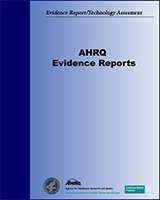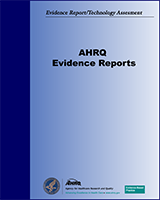NCBI Bookshelf. A service of the National Library of Medicine, National Institutes of Health.
Lau J, Zucker D, Engels EA, et al. Diagnosis and Treatment of Acute Bacterial Rhinosinusitis. Rockville (MD): Agency for Health Care Policy and Research (US); 1999 Mar. (Evidence Reports/Technology Assessments, No. 9.)
This publication is provided for historical reference only and the information may be out of date.
This evidence report highlights the need to improve the quality of studies in both diagnosing acute bacterial rhinosinusitis and evaluating outpatient treatment options. Assessment and comparison of the available evidence emphasize the need for increased rigor in future research study design and implementation. Several specific areas for future research are identified by the qualitative and quantitative gaps in the evidence found for this report. In addition, the uncertainties encountered in the decision analysis models suggest areas of needed research for the translation of evidence into clinical decisions.
For studies of both diagnosis and treatment, there is a need for improvements regarding several general study design issues. First, the characteristics of patients enrolled in studies need to be clearly defined. This is critical to insure internal validity and allow for study comparisons and data analyses. It is also critical when clinicians attempt to apply the study results to clinical practice. Study protocols, however, should rigorously identify patients with acute bacterial rhinosinusitis using direct bacteriologic evaluation (e.g., antral puncture and aspiration) or standardized radiographic imaging as entry criteria. Particularly for treatment studies, the need for increased distinction of the patient populations in evaluations underscores the need to study patients with chronic and subacute rhinosinusitis separately from patients with acute rhinosinusitis.
In addition to improved definition of patient populations, there is a need for improved description of study populations, test methods, and criteria for test-positive determinations. Both description and implementation of patient randomization and the blinding of investigators are required. Because of the subjective nature of the relevant endpoints, double-blinding is exceptionally important in evaluating treatments for acute bacterial rhinosinusitis.
Future work evaluating diagnostic tests for acute bacterial rhinosinusitis may follow several lines of investigation. Current and future diagnostic modalities need to be rigorously evaluated and compared with a reference standard. To date, there are no published comparisons of either computed tomography or magnetic resonance imaging with other diagnostic modalities, such as sinus puncture or radiography for acute bacterial rhinosinusitis. The clear cross-sectional images provided by these technologies may offer improved discrimination between patients with rhinosinusitis and those without. Studies comparing ultrasound or transillumination with sinus puncture need to evaluate the extent of operator training on the results.
In addition, newer culturing techniques such as middle meatal cultures have not been rigorously compared with sinus puncture (Gold and Tami, 1997). Importantly, given the limitation of sinus puncture (that it is limited to sampling the maxillary sinuses, requires referral to a specialist or specific training for the general practitioner, and is not readily acceptable to patients), there is a great need for better noninvasive methods for diagnosing acute bacterial rhinosinusitis (Hansen, Schmidt, Rosborg, et al., 1995; Lindbaek, Hjortdahl, and Johnsen, 1996b). Further research into techniques, such as middle meatal sampling, may provide alternative methods for more readily applicable, direct bacteriologic evaluations. These may also help in studies to better understand the clinical correlation of abnormalities of the nonmaxillary sinuses.
Since the most cost-effective diagnostic method appears to be the use of clinical criteria to guide treatment, identifying clinical criteria with improved diagnostic accuracy, perhaps through the development of risk scores or other clinical decision aids, may prove particularly fruitful. In addition to using clinical criteria to a make diagnosis and guide treatment, clinical criteria may be used to single out patients for additional (and more expensive) diagnostic tests.
Many clinical trials of various antimicrobials for treating acute sinusitis continue to be carried out, and the majority compare new expensive antibiotics that have extended spectrum with each other (Evidence Table 9). Inexpensive antibiotics such as amoxicillin or folate inhibitors are only infrequently used as controls. Comparison of a newly released, expensive antibiotic with other antibiotics with an expanded spectrum of activity instead of amoxicillin or folate inhibitors may avoid the potential for finding that the new drug is only about equivalent to an inexpensive agent. However, despite many trials, there is still not enough evidence to suggest that use of any of the newer, more expensive agents offers any meaningful advantage in the management of acute bacterial rhinosinusitis that would justify the extra cost. For the same reason, the evidence for the superiority of any antibiotic treatment over placebo has been established on relatively limited data, considering the high prevalence of acute bacterial rhinosinusitis. It is still possible that in many cases no antibiotic treatment is needed, as has been debated in the treatment of acute otitis media in children.
Along with comparisons of antibiotic classes, further study into the optimal duration of treatment should be addressed. The analyses in this report could not address this issue, since most studies used treatments of 10 to 14 days in duration. A recent well-designed trial of short-term (3 days) vs. traditional (10 days) treatment of sinusitis shows it is possible to conduct high-quality studies in this domain (Williams, Holleman, Samsa, et al., 1995).
In the future, comparative studies will need to consider antibiotic resistance as a factor in choosing drugs for comparison. Future studies should not exclude patients infected with resistant bacteria but should specifically study populations with a high prevalence of resistant organisms. If a trial is focusing on bacterial resistance to chosen antibiotics, bacteriology should be done using antral puncture and aspiration or alternative procedures for microbiologic evaluation. Data are needed regarding patients with resistant organisms, specifically, information of extent of resistance and effects on patients' responses to treatment. Correlation between laboratory minimal inhibitory concentration values and clinical response will be needed to guide future antibiotic treatment choices. Additionally, there is a need for surveillance programs to provide information regarding local, national, and global patterns of antibiotic resistance to aid treatment decisionmaking.
More studies are needed to look at optimal ancillary treatment regimens for acute bacterial rhinosinusitis, since evidence for the effectiveness of widely used therapies is lacking. In addition, in studies of antibiotic treatments, any use of over-the-counter medications should be clearly regulated and standardized to allow rigorous evaluation of the incremental benefit of antibiotics.
For all studies of treatment, clinical outcomes should be defined explicitly, using detailed physician and/or patient scoring. As seen with the decision models, a patient's preference can alter the assessments of a strategy's effectiveness. Limited studies suggest that one of the major effects of antibiotic treatment is shortening the length of symptoms, and as such, assessments of outcomes at different time points may better represent the differential effect of an antibiotic as compared with placebo. In addition to a need for better understanding of the connection between treatment and time to resolution of symptoms, there is a need for more information on treatments and relapse rates or the potential development of recurrent bacterial rhinosinusitis. More widespread population studies are needed to obtain data on complication rates. Large-scale studies are needed because the events are rare.
Rigorous, narrowly defined studies need to be balanced with studies for direct clinical application. Not only are clinical studies with better defined patient populations needed, but studies of patients in the community setting also are needed to assess their similarities and differences compared with the research populations. As evidenced in the decision analyses, for both diagnosis and treatment of acute bacterial sinusitis, the most effective and cost-effective strategies can be influenced by disease prevalence. Prevalence of acute bacterial rhinosinusitis varied widely in different studies in this report. Some of the differences may be due to practice setting, seasonal variation, or geographic variation. Some may result from preselection of patients for studies. Future studies should also be dedicated to specific patient populations such as patients with comorbidities (e.g., allergies, asthma, and HIV infection) that may influence the development, progression, and response to treatment of acute bacterial rhinosinusitis.
More primary care research and population studies are needed to better understand the factors affecting prevalence and to enable widespread application of the research results. Much of the current population data are based on insurance claims whose correlation to the presence of microbiologically defined acute bacterial rhinosinusitis is unknown. Research to assess and optimize the correlation between claims data and rigorous diagnosis is needed.
Many patients with acute bacterial rhinosinusitis do not see their providers, and many are never treated. Study of these patients as compared with those seeking treatment may help to better distinguish those requiring treatment from others. Additional studies in the primary care setting also may help to increase understanding about the influences of patient factors (patient-physician interactions, availability of time for sickness, variability of severity of episodes) on the process of applying evidence into clinical practice.
- Future Research - Diagnosis and Treatment of Acute Bacterial RhinosinusitisFuture Research - Diagnosis and Treatment of Acute Bacterial Rhinosinusitis
- Summary - Evaluation of Technologies for Identifying Acute Cardiac Ischemia in E...Summary - Evaluation of Technologies for Identifying Acute Cardiac Ischemia in Emergency Departments
Your browsing activity is empty.
Activity recording is turned off.
See more...

